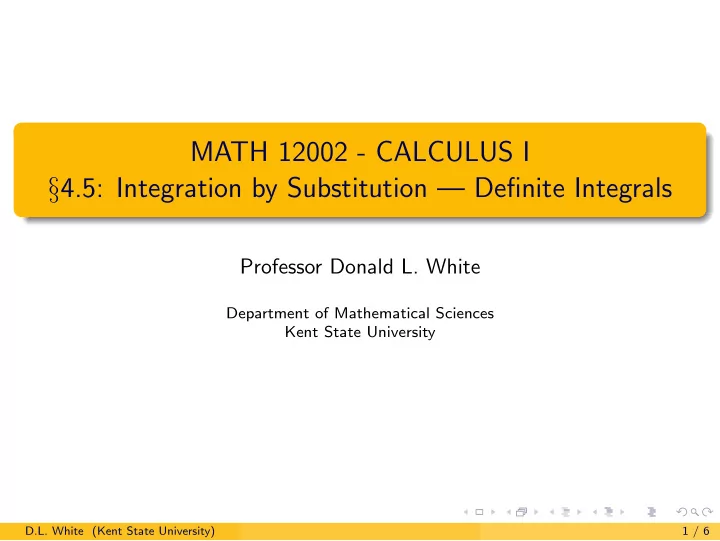

MATH 12002 - CALCULUS I § 4.5: Integration by Substitution — Definite Integrals Professor Donald L. White Department of Mathematical Sciences Kent State University D.L. White (Kent State University) 1 / 6
Substitution and Definite Integrals By the Fundamental Theorem of Calculus, if F is an antiderivative for f , then � b f ( x ) dx = F ( b ) − F ( a ) . a Hence one option for computing a definite integral requiring substitution is to find an antiderivative (i.e., indefinite integral) F ( x ) by substitution, and then compute F ( b ) − F ( a ). This involves some unnecessary steps, however: � Computation of the indefinite integral f ( x ) dx must be done separately. “Back substitution” after integrating is necessary to return the integral to a function of x before evaluating. The antiderivative must be put back in the definite integral computation to evaluate. There is an easier way! D.L. White (Kent State University) 2 / 6
Substitution and Definite Integrals � b When we write a f ( x ) dx , the differential dx tells us that the variable is x and we are integrating from x = a to x = b . The entire integral, including the limits of integration, is in terms of x . When we make a change of variable, we must change the limits of integration to correspond to the new variable. � b That is, for a f ( g ( x )) g ′ ( x ) dx , we have u = g ( x ) = g ′ ( x ) dx du x = b ⇒ u = g ( b ) x = a u = g ( a ) ⇒ and then � b � g ( b ) f ( g ( x )) g ′ ( x ) dx = f ( u ) du . a g ( a ) The integral can be computed as on the right without back substituting . D.L. White (Kent State University) 3 / 6
Examples � 2 1 x 2 ( x 3 + 1) 4 dx . 1 Evaluate the integral � 2 � 2 x 2 ( x 3 + 1) 4 dx x 2 ( x 3 + 1) 4 dx = 1 1 u = x 3 + 1 du = 3 x 2 dx 3 du = x 2 dx 1 x = 2 ⇒ u = 2 3 + 1 = 9 x = 1 ⇒ u = 1 3 + 1 = 2 � 9 u 4 du = 1 � 9 1 3 · 1 5 u 5 � = 3 2 2 15(9 5 − 2 5 ) = 59049 − 32 1 = 59017 = . 15 15 D.L. White (Kent State University) 4 / 6
Examples � π/ 2 cos 10 x sin x dx . 2 Evaluate the integral 0 � π/ 2 � π/ 2 cos 10 x sin x dx (cos x ) 10 sin x dx = 0 0 u = cos x du = − sin x dx ( − 1) du = sin x dx x = π/ 2 ⇒ u = cos( π/ 2) = 0 x = 0 ⇒ u = cos 0 = 1 � 0 0 u 10 du = − 1 � 11 u 11 � = − � 1 � 1 − 1 11(0 11 − 1 11 ) = − 1 11( − 1) = 1 = 11 . D.L. White (Kent State University) 5 / 6
Notes Compute the integral in terms of u . Do not back substitute. If you do back substitute, change limits back to x -values. In each step, the limits of integration must correspond to the variable used in that step. The following is incorrect: � π/ 2 � π/ 2 cos 10 x sin x dx u 10 du = − LIE 0 0 � π/ 2 − 1 11 u 11 � = 0 � π/ 2 − 1 11 (cos x ) 11 � = LIE 0 − 1 = 11 (cos( π/ 2) − cos 0) − 1 11 (0 − 1) = 1 = 11 . D.L. White (Kent State University) 6 / 6
Recommend
More recommend